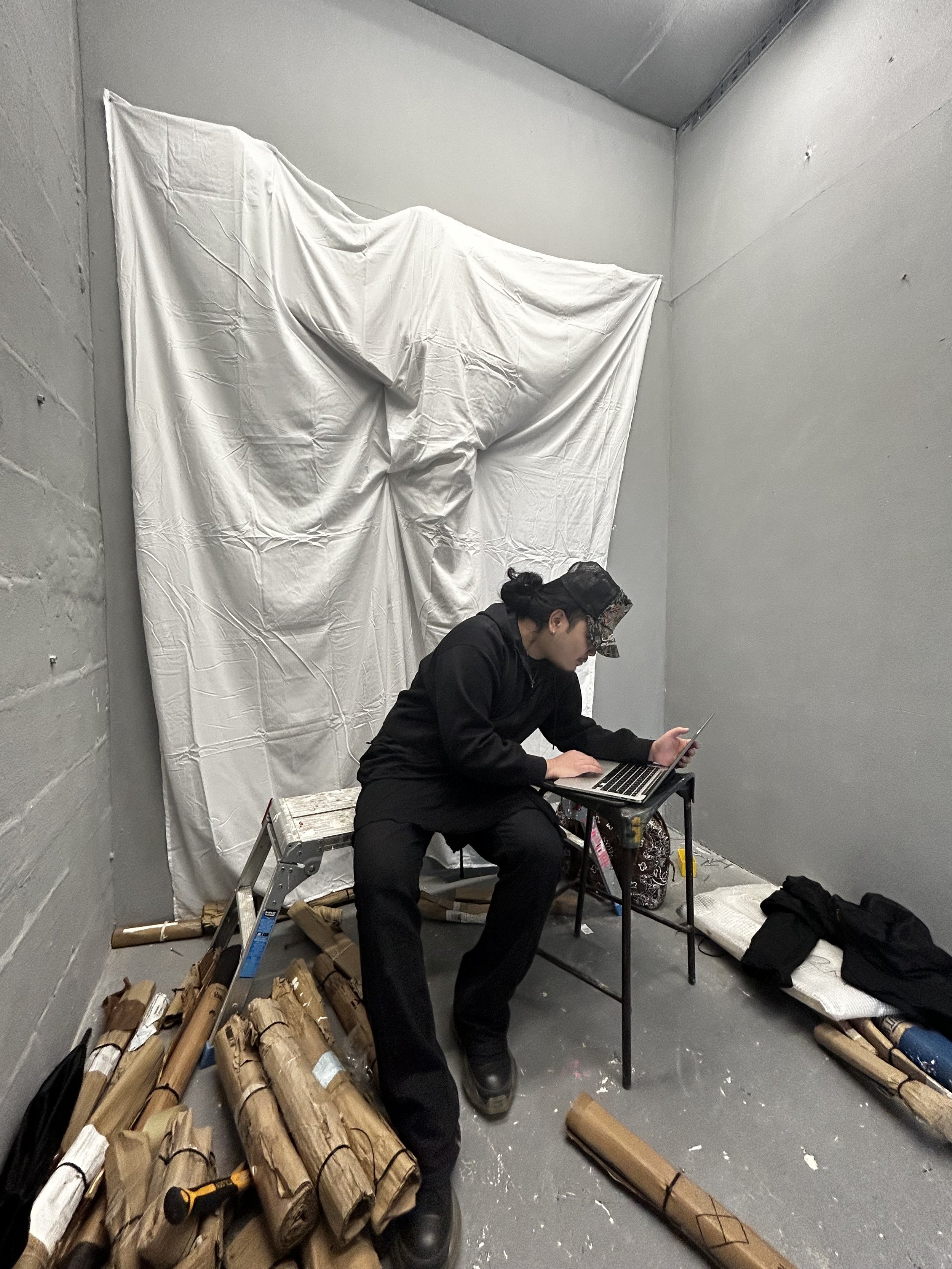Sculpting The Sublime: Jan Diaz
TW: mummification
Artist Jan Diaz in his studio space
Within the tapestry of our existence, the interplay between faith and the real world often weaves a complex narrative that transcends the boundaries of our beliefs. It is here within the intersection of Catholic ideology that artist Jan Diaz has been able to encapsulate the profound threads of faith and religion through his sculpture. Diaz emerges as a captivating artist whose creative journey unfolds as an exploration into the intricacy of ritual, materialism, and the nuances of iconography found within biblical scripture.
His artistic evolution initially gravitated towards the imagery ingrained in his Roman Catholic upbringing, particularly within the fascination of the sublime, the image of God, and the yearning to draw closer to a higher being through spiritual and ritualistic practices. His early works bear witness to an internal struggle with confronting his own faith and the stark realities that seemingly contradicted those very beliefs.
03/10/23
The use of draping and casting within his works visualise this reenactment of his concealment, taking inspiration from the conceptual brilliance of artists like Christo and Jeanne-Claude, who’s work involved wrapping iconic structures such as the Arc de Triomphe. Through this, Diaz has solidified the metaphor of his own human tendency, one that has the ability to mask intrinsic characteristics until they are confronted. The use of materials such as white seamless fabric cast in plaster laid the foundations for Diaz’s evolving artistic practice, pushing the boundaries further resulting in the curation of the “bound figure”.
“Bound Figure” -2022
Diaz’s exploration for this piece draws inspiration from the mummification practices observed in Pompeii. Captivated by the encapsulation and preservation of a moment in time, he identifies parallels in his casting process, seeing it as a medium to replicate his state of mind and revelations. Initially Diaz cast this form in an aim to suggest human nature but it resulted in a more visceral and harrowing representation of horror and an unexpected state of reality. When exhibited, he placed the figure below a spherical object that resembled a ghost-like appearance close to the symbolic image of the Holy Ghost. Here Diaz creates an impressive symbolic narrative - a figure grounded on earth, looking up to an idealised form that’s beyonds its reach. The draped fabric and use of string around the neck signifies both hope and suffocation, embodying the fragile dance between earthly existence and the pursuit of perfection.
In the subsequent phases of his artistic exploration the focus shifted to the human body as an embodiment of the divine with a particular emphasis on his own being. As explored earlier, his earlier works became a nuanced expression of religious concealment naturally inviting his newest concept of statue and icon to emerge organically. Against the back-drop of the socio-political turbulence ignited by the death of George Floyd, a period when societal icons were under heavy scrutiny for their unethical and brutal actions, he drew inspiration from the protective covering of the statue of Winston Churchill during this turbulent time to prevent vandalism from protestors. This pivotal moment propelled his work into the realm of socio-politics whilst still drawing parallels to Catholicism.
Untitled piece for Copeland Gallery - 2024
In seeking to explore these nuanced themes, Diaz aimed to convey the hypocrisy inherent in the reforms undertaken by the Church to align with modern morality and the contemporary conversations surrounding the false representation of Jesus’ ethnicity posing geopolitical implications of “white-washing”. Ultimately this led him to display a meticulous examination of the anatomy of the crucifixion through a number of drawings and sculpting in clay, with the end result being a number of exhibited castings.
Presentation for Camberwell pop up exhibition - 2023
This final piece was presented as a performance piece within a group of nine people, with each member having a dedicated cast forming a collective that took on a suggestive arrangement reminiscent of a firing line. In a thought-provoking move, Diaz invited the audience to actively participate in the destruction of these sculptures. This spectacle unfolded as a symbolic act, resulting in a pile of disfigured bodies and debris which culminated into a chaotic assembly.
This performative act encapsulated a profound commentary on socio-politics and cancel culture. The audiences lack of objection to the brutal dismantling of Christian iconography reflected that of current societal norms and collective behaviours, marking a poignant conclusion to his exploration.
After image of Jan’s performative piece consisting of debris - 2023
Within my own exploration of censorship within the media, Diaz’s sculpture takes on a profound significance. The public itself has become an actor and not a fixed body of individuals being composed of sheep in need of a shepherd, aborting all sense of individuality. Diaz’s sculptures are a compelling reflection of the complexities inherent in our consumption of media, illustrating how we often take it at face value. This is apparent in distressing regularity and underscores the phenomenon of swift public condemnation, commonly referred to as “cancel culture”.
Walter Lippmann, an influential commentator, illustrates this by describing how ordinary individuals often navigate the complexities of the world based on the “pictures in their heads,” relying on disconnected meanings and crude stereotypes. This concept resonates deeply within our modern context, where our minds are inundated with oversimplified narratives leading to a lack of interest to educate ourselves on a deeper level. Diaz’s performance piece serves as a commentary on this, highlighting how we lead with our superficial understandings, brutally smashing religious figures strips away the layers of historical significance and cultural meaning.
One significant lesson I continue to acknowledge and take from his art form, is the ability to practice my individual agency to navigate my own thinking and the complexities I come across in my own life.
As Diaz’s artistic narrative continues to unfold, it is with anticipation and excitement that we look forward to seeing what he presents to the world next. The evolution of his themes, techniques and bold narratives engages with societal discourse which promises a future filled with more thought-provoking and impactful works that invite audiences to delve deeper into the layers of faith, identity and societal dynamics. His trajectory is a testament to the evolving nature of his creative expression.






